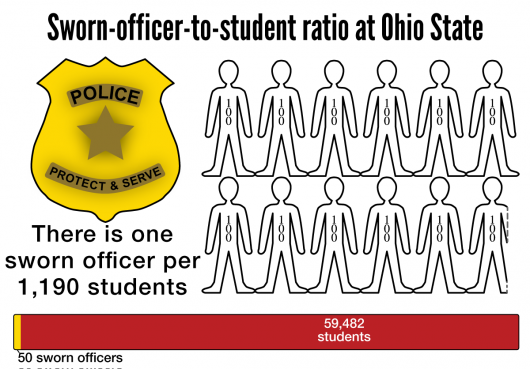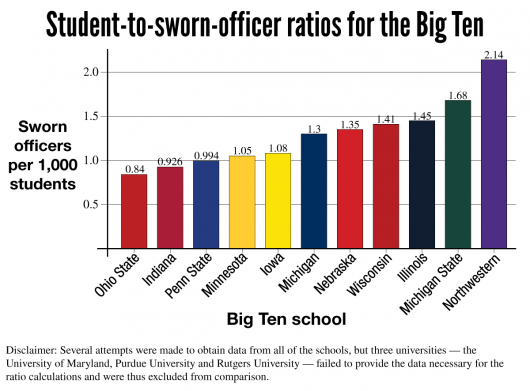[author image=”https://www.thelantern.com/files/2017/07/Amanda-Etchison-1sjc3d0.png” ]Amanda Etchison produced this content in her role as Patricia B Miller Reporter.[/author]

In an Analysis of Big 10 and Midwestern schools, Ohio State was found to have the lowest police to student ratio at 0.84 sworn officers per 1,000 students. Credit: Michael Huson | Managing Editor for Content
In the hours following an attack on Ohio State students and faculty on Nov. 28, University Police received praise from state, local and national officials for its quick response.
Officer Alan Horujko, hired in January 2015, was nearby and fatally shot Abdul Razak Ali Artan, a third-year in logistics management who attacked campus with a car and a knife, which resulted in 11 people being sent to the hospital.
But as university officials continue to work with investigators and with the community to restore a sense of security on campus, some have been questioning the number of officers on campus, determining that it’s too few to adequately protect the student population.
A staffing analysis published in May 2013 by the OSU Police Division expressed a need to hire “10 to 13 full-time police officers to balance the amount of time required for response calls.”
At the time, the report states, OSU’s Columbus campus employed 47 sworn police officers, which is a decrease from 53 officers in previous years.
About two and a half years later, OSU has added three more sworn police officers to its force, bringing its total number of full-time sworn officers to 50.
A Lantern analysis of campus police divisions on the main campuses of Big Ten universities shows that, despite these additions to the staff, OSU has the lowest ratio of police officers to students when compared with other schools in the conference that submitted data for this story.
OSU currently has 0.84 sworn officers per 1,000 students on its Columbus campus. This is slightly higher than the ratio reported by The Lantern in a March 2014 article, which stated that the number was about 0.80 sworn officers per 1,000 students.
The Big Ten average ratio based on Autumn 2016 data is 1.30 sworn officers per 1,000 students.
In an email, Department of Public Safety Director Monica Moll declined to comment on “the practices or safety and security needs of other campuses or universities,” or how OSU compared to other Big Ten schools.
Instead, she emphasized the partnerships University Police have with other law enforcement divisions in the Columbus area, which she said were shown when several agencies aided in responding to the violence that unfolded on campus last week.
“As you witnessed (on Nov. 28), we have the ability through our mutual aid agreement to receive immediate assistance from Columbus police and other nearby agencies in emergency situations,” she said.
Moll added that other on-campus resources should be considered beyond the number of sworn officers when looking at campus safety.

“Like Ohio State, all universities have their own safety considerations which include, but are not limited to, population, location or proximity to a major city, total public safety (personnel) and actual crime rates,” she said. “At Ohio State, our comprehensive safety approach includes police, security, technology and surveillance as well as important partnerships with local, state and federal law enforcement.”
Columbus Division of Police Sgt. Shaun Laird, a national trustee for Ohio for the Fraternal Order of Police, said the violent event on campus reiterates the importance of assessing how many sworn police officers are present on OSU’s force.
“In a violent situation … the officer is the one who has to defuse the violent person,” said Laird, who represents several local police agencies, one of which is OSU’s University Police. “I would ask people that when that situation happened, where were the cameras, where were the Student Safety (Services) people?”
Ohio State last in past comparisons of the Big Ten
This isn’t the first time that OSU has had the lowest officer-to-student ratio in the Big Ten.
The 2014 Lantern article featured a study conducted by Capt. Eric Chin of the Purdue University Police Department, which showed that OSU had the lowest ratio compared with 15 Midwestern and Big Ten universities.
Chin’s original study included all Big Ten universities, as well as the University of Notre Dame in Indiana.
Laird said he and the OSU officers he represents were disappointed with the staffing numbers at OSU when they compared them to the other schools.
“A couple of years ago, when we did this story, when we looked at the numbers, we were discouraged at the time to find that OSU was at the bottom of the pile in the Big Ten,” he said. “We were looking at that officer-to-student ratio, and we felt that that number really needed to be increased.”
The number of sworn officers did increase from 47 to 50, but the number of students on campus also increased.
According to data listed on OSU’s website, there are 59,482 undergraduate and graduate students currently enrolled on the Columbus campus for Autumn Semester 2016. The student population was listed as 56,387 in Chin’s original study.
OSU had the largest main campus student population among the Big Ten schools included in The Lantern’s analysis, with approximately 8,000 more students than the University of Minnesota’s Twin Cities campus, the school with the second-largest student population.
Minnesota’s officer-to-student ratio is approximately 1.05 sworn officers per 1,000 students.
Northwestern University, the school with the highest officer-to-student ratio, had 30 sworn police officers on its force but has a main campus population of about 14,000 students. Its ratio was 2.14 officers per 1,000 students.
The school with the second-highest officer-to-student ratio, Michigan State, also had one of the largest student populations. With 51,189 students and 86 sworn police officers on its East Lansing campus, its ratio was 1.68 officers per 1,000 students.
Three schools — the University of Maryland, Purdue University and Rutgers University — failed to provide the data necessary for the autumn 2016 ratio calculations and were thus excluded from The Lantern’s comparison.
Safety services, security and other considerations
Moll said an analysis of campus safety should extend beyond just the sworn-officer-to-student ratio in order to “take into account the holistic approach of each university.”
She added that, in addition to the 50 sworn police officers on OSU’s campus, the division also employs 35 non-sworn security officers who serve the academic campus and 71 non-sworn officers who serve the Wexner Medical Center.
Although these non-sworn officers are uniformed and trained, they are not armed like the sworn officers, she said.
These non-sworn officers do not have arrest power nor do they possess police badges like those carried by sworn officers, OSU Administration and Planning spokesman Dan Hedman added in a follow-up email.
“These personnel are also supplemented by part-time security officers and Student Safety Service officers,” Moll said.
She added that “significant technology,” such as the more than 2,500 surveillance cameras used by the Department of Public Safety, should be taken into account as well.
Yet Laird said these resources, while helpful, should not be considered a replacement for sworn police officers.
“I do think it is important that we have those things, but it does not replace a police officer when a violent situation occurs,” he said.
Laird also pointed out that OSU is not alone in offering these security resources in addition to a police department.
“It is not like at the University of Wisconsin they don’t provide that … Every university has those same things,” he said. “So we get back to the root question of, if every university has those prevention programs and cameras and student safety, how do you still have a lower number of officers per thousand?”

Credit: Robert Scarpinito | Managing Editor of Design
Ratio revisions among a changing campus population
The University Police staffing report was based on data collected throughout 2012 from the division’s computer-aided dispatch system, which tracks calls received and the actions taken by the department for each call.
Based on the data, the report states that the analysis “supports the need for hiring” 10 to 13 additional full-time officers, which would “balance the amount of time required for response calls from our community.”
The report’s conclusion also notes that the study did not take into account how the mandatory on-campus living requirement for second-year students or a hospital expansion project would impact the suggested staffing increases.
Laird said changes like these should be taken into consideration when looking at the number of officers on the campus force.
“I think (OSU is) going to need to continue to evaluate with every step of expansion to be able to provide for those people,” he said. “If we are expanding the student population … especially in those who are living on campus, because now you are going from when you (were) providing services for maybe a few hours of the day, now you are providing services for a whole sophomore population for basically 24 hours a day.”
There is expansion happening beyond the student population, though. New officer positions are set to be added to the University Police force, funded by money generated by alcohol sales in Ohio Stadium during game days.
In September, it was announced that University Police would be hiring four full-time officers at an estimated annual cost of $600,000. This was an increase from the initial estimate, which planned to add two new full-time officers to the force.
The addition of four officers would increase OSU’s ratio to 0.91 officers per 1,000 students when calculated with current enrollment numbers for Autumn 2016.
This would still be the lowest ratio among the Big Ten schools. The second-lowest ratio is Indiana University’s 0.926 officers per 1,000 students on its Bloomington, Indiana, campus.
Laird said he sees this as a step in the right direction, but again emphasized the need to continuously evaluate the ratio between officers and students as the campus population grows.
“The overall view to me was we said something to them a couple of years ago, we said they needed more (officers), and they are moving that way,” he said. “They may look at it and say, ‘Oh, we added four,’ but our needs have really grown and we may need to add more. At every step of expansion, you are going to have to stop and look at where you are at and then see if the number is working or if you need to add some more people.”
Methodology
For this story, The Lantern analyzed data collected from 11 of the 14 universities in the Big Ten conference.
Several attempts were made to obtain data from all of the schools, but three universities — the University of Maryland, Purdue University and Rutgers University — failed to provide the data necessary for the ratio calculations and were thus excluded from comparison.
Information requested of each school was kept the same for each inquiry. The Lantern asked the universities to provide the number of students of all levels enrolled for Autumn Semester 2016 on the main campus of each institution, as well as the number of sworn police officers serving that campus.
A ratio was then calculated to determine the number of police officers per 1,000 students on the main campuses of Big Ten universities.


